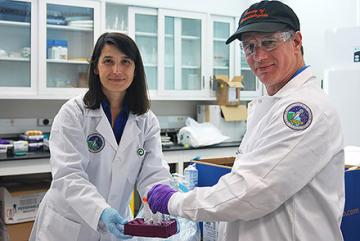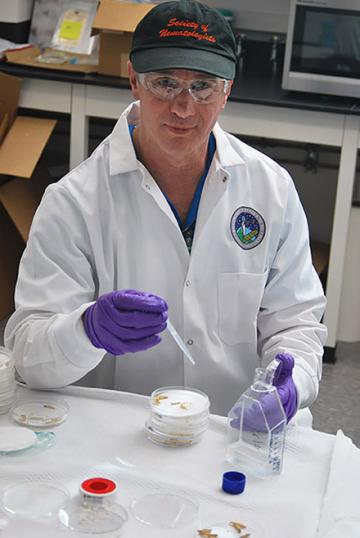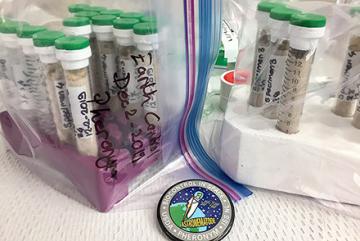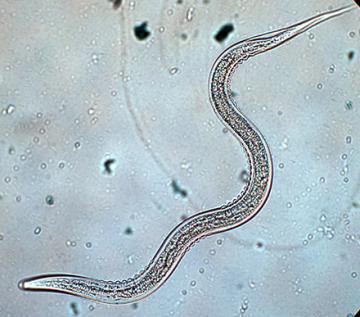Nematodes in Space: The Final Frontier for Little Worms

Fatma Kaplan, from Pheronym, Inc. (left), and ARS research entomologist David Shapiro-Ilan prepare nematodes at NASA's Kennedy Space Center in Florida, prior to being loaded on a rocket for their trip to the International Space Station. (Laura Lucy-Ilan, D4688-1)
There is no shortage of challenges when it comes to space travel and colonization–having enough oxygen, food, and water for long flights, to name a few. Agricultural Research Service (ARS) scientists and their colleagues recently focused their attention on another: stowaways.
Researchers at ARS’s Southeastern Fruit and Tree Nut Research Station in Byron, GA, teamed with Pheronym, Inc., a company that specializes in eco-friendly pest control, to send beneficial nematodes, known as entomopathogenic nematodes, to the International Space Station (ISS) to study their ability to function under microgravity conditions.
Why would one deliberately take insects aboard a spaceship? According to ARS research entomologist David Shapiro-Ilan, it’s to prepare astronauts for a possible terrestrial conflict while in space.

ARS research entomologist Dr. David Shapiro-Ilan prepares waxworm caterpillars infected with nematodes at NASA's Kennedy Space Center in Florida prior to being loaded on the rocket for their trip to the International Space Station. (Laura Lucy-Ilan, D4690-1)
“In the future, humans will likely spend long periods in space due to prolonged space travel or even living in space-settlements,” he said. “It will be important to grow food in space to sustain humans and possibly livestock. We expect that pests will inadvertently be introduced to the crops that are being grown. Exotic invasion of pests into agriculture is a well-established problem; similarly, we expect that pest invasion into space agriculture will also become a challenge.”
Entomopathogenic nematodes are very small, often microscopic, roundworms that are natural biopesticides and kill insect pests. The nematodes carry bacteria in the gut that overpowers their target insect’s immune system within 24-48 hours.
Shapiro’s nematodes were examined aboard the ISS in conical tubes filled with sand. They were tested on their ability to move through the soil, find and kill wax moth caterpillars, and reproduce. Results indicated that the nematodes in space performed similarly to those on Earth. Moreover, the insect immune system response and symbiotic bacteria load were similar in space and on Earth.

Tubes containing sand and about 2,000 nematodes each are prepared and bagged ready for their trip in space. Some will be removed and frozen during the study at the International Space Station, while others will remain alive and studied upon return to Earth. (Laura Lucy-Ilan, D4691-1)
The findings are important for several reasons, Shapiro said, including astronaut safety and the limited storage capacity inherent in space travel. “Chemical insecticides are toxic to humans and other nontarget organisms,” he said, “especially when people will be living or travelling in enclosed environments.”
To save on storage space, astronaut farmers will be able to mass produce their own supply of nematodes. The beneficial bugs are extremely prolific in terms of reproduction, with up to hundreds of thousands of baby nematodes emerging from each killed target pest.
Shapiro and his partners are looking ahead to other beneficial space travel and exploration projects, including possibly conducting larger-scale projects involving a small greenhouse with crop plants.

Entomopathogenic nematodes, like Heterorhabditis indica, were recently sent to live on the International Space Station to study their ability to function under microgravity conditions. (Kathy Halat, ARS D4692-1)
“Space ag will be important in the future, such as during long space flights or in space colonization,” Shapiro said. “This was the first experiment involving natural (agriculture biological) control of insects in space. Moreover, we gleaned fundamental knowledge on the nematode behavior, symbiosis, and parasitology.”
Basic knowledge on the biology of beneficial nematodes can be leveraged to enhance environmentally friendly pest management strategies on Earth, he said.
This initial investigation was sponsored by the ISS U.S. National Laboratory, which works in coordination with NASA to fully utilize the orbiting laboratory to bring value to our nation through space-based research and technology development. – By Scott Elliott, ARS Office of Communications.
You May Also Like

